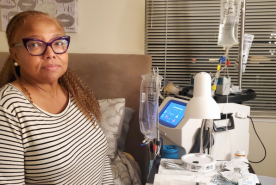Table of Contents
- How hemodialysis works
- Hemodialysis: At home or in-center
- Different types of home hemodialysis
- Added benefits of short daily and nocturnal home hemodialysis
- New technology
- Deciding if home hemodialysis is right for you
- Finding a center that offers home hemodialysis
- Your care partner
- Insurance coverage for home hemodialysis
- Online information
When you are told you have kidney failure and need treatment to stay alive, it can be a difficult time in your life. If your kidney diagnosis is new, you may feel overwhelmed, confused and angry. But there are some important things you can do to help yourself. Learn all you can about your different treatment options and take an active role in decisions about your care.
How hemodialysis works
Hemodialysis is a treatment that replaces the work of your own kidneys to clear wastes and extra fluid from your blood. This is done using a special filter called a dialyzer or artificial kidney. Your blood travels through plastic tubing to the dialyzer, where it is cleaned and then returned to you. At the beginning of each treatment, two needles are placed into your access. These needles are connected to the plastic tubing that carries your blood to the dialyzer. Only a small amount of blood is out of your body at any one time. The dialysis machine pumps your blood through the dialysis system and controls the treatment time, temperature, fluid removal and pressure.
This basic process is the same for home hemodialysis, except that you and a care partner are trained to do your treatment at home.
Hemodialysis: At home or in-center
You can do hemodialysis at a dialysis center where a nurse or technician performs the tasks required during treatment. In-center hemodialysis is usually done three times a week for about three to four hours or longer each session. In-center treatments are done at a pre-scheduled time.
You can also do hemodialysis at home where you are the one doing your treatment. At home, you may be better able to fit your treatments into your daily schedule. Studies show that the more you know about your treatment and the more you do on your own, the better you are likely to do on dialysis.
Different types of home hemodialysis
Three types of hemodialysis can be performed at home. They are:
- Conventional home hemodialysis: You do this three times a week for three to four hours or longer each time. You and your care partner are trained to do dialysis safely and to handle any problems that may come up. Training may take from several weeks to a few months.
- Short daily home hemodialysis: This is usually done five to seven times a week using new machines designed for short daily home treatment. Treatments usually last about two hours each. You and your care partner are trained over several weeks. Because you are doing dialysis more often, less fluid generally needs to be removed each time. This reduces symptoms like headaches, nausea, cramping and feeling “washed out” after treatment.
- Nocturnal home hemodialysis: Long, slow treatments done at night while you sleep. You may do this kind of dialysis six nights a week or every other night. This depends on what your doctor prescribes for you. Treatments usually last about six to eight hours. You and your care partner are trained over several weeks. Some centers monitor your treatments by sending information from your dialysis machine to a staffed location by telephone modem or the Internet. More hours of dialysis each week can result in more waste removal.
It is also possible to combine daily and nocturnal home hemodialysis. Whether you can combine treatments depends on your needs, your medical condition and your machine.
Whatever treatment option you choose, it is important to know if you are getting the right amount of dialysis. Tests should be done regularly to check the amount of dialysis you receive. For more information, speak with your doctor and your dialysis care team.
Added benefits of short daily and nocturnal home hemodialysis
Many reports indicate that people using short daily and nocturnal home hemodialysis:
- Take less medication to control blood pressure and anemia
- Take less medication to keep phosphorus under control to help prevent bone disease
- Have improvements in neuropathy (nerve damage) and less restless leg syndrome
- Feel better during dialysis and less “washed out” after
- Have more energy for daily tasks
- Sleep better
- Have fewer and shorter hospital stays
- Have better quality of life
- Live longer
Deciding if home hemodialysis is right for you
Home hemodialysis is not a good fit for everyone. You need to learn a lot about it. You need to be willing to be responsible for your own treatment. As long as you and/or your care partner can pass the training and learn to place your needles, you should be able to do home hemodialysis.
Check out our online communities to connect, learn more and hear from others going through similar experiences.
Finding a center that offers home hemodialysis
Finding a center that offers home hemodialysis can be a challenge. If your center does not offer home hemodialysis, see below for Web sites that can help you find centers that offer home hemodialysis. Visit the center. Talk with the home training nurse and other staff. If possible, talk with home patients. Two things are needed for success: 1) a center and doctor willing to train you and follow your care and 2) your commitment to learn and do home hemodialysis for at least a year.
Your care partner
Most home hemodialysis programs ask you to have a care partner who is willing to be with you to help during each treatment. Your care partner can be a family member or friend. This person goes through the training with you so he or she can learn what to do. Sometimes, patients hire a nurse or technician to be their care partner. Medicare does not pay for these helpers, however.
Insurance coverage for home hemodialysis
The social worker at your dialysis center should give you information about coverage for home hemodialysis. Medicare pays for part of the cost and training. If you are 65 or older or disabled, you should already have Medicare. You can also get Medicare at any age if you have kidney failure and you or your spouse or parent worked long enough to qualify for Social Security. There are other sources that help pay for dialysis. Check with your social worker. He or she can also discuss any plumbing or wiring changes or additional costs that may occur with home hemodialysis.
If you have an employer group health plan, it will be the primary coverage for the first 30 months of your treatment with Medicare as your secondary insurer. After those first 30 months, Medicare will become your primary insurance.
For more on home hemodialysis see the following PDF brochure:
Have You Thought About Dialysis at Home?
Online information
Dialysis Facility Compare—Find information about dialysis centers that offer home hemodialysis training programs. www.medicare.gov
Home Dialysis Central—Learn about home dialysis options, talk to other patients, find out if a dialysis center near you offers a home hemodialysis program. www.homedialysis.org
If you would like more information, please contact us.
© 2015 National Kidney Foundation. All rights reserved. This material does not constitute medical advice. It is intended for informational purposes only. Please consult a physician for specific treatment recommendations.








